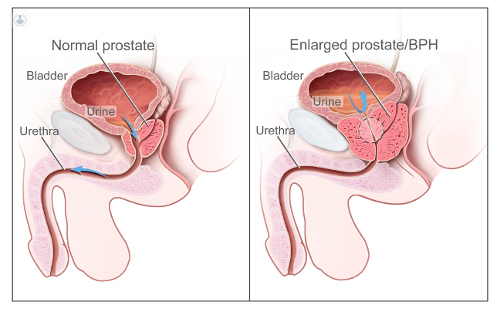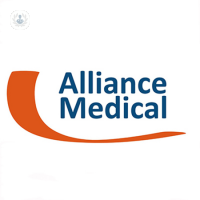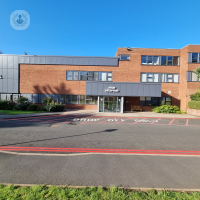What is prostate artery embolisation?
Prostate artery embolisation is a minimally invasive procedure carried out under local anaesthetic that treats enlarged prostates by cutting off the arteries that feed the gland, hence making it shrink in size. This procedure is performed by interventional radiologists.

Why would you need prostate artery embolisation?
If you are suffering from benign prostate enlargement, then prostate artery embolisation is a treatment option to reduce the size of the enlarged prostate. Benign prostate enlargement can seriously affect the quality of life of those suffering, so finding a treatment to relieve the symptoms is important.
What does prostate artery embolisation involve?
During prostate artery embolisation, a catheter-like tube is inserted into an artery in your groin region. Once the position is correct, checked by an X-ray, the tube is inserted into both prostate arteries.
When the catheter is positioned in the prostate arteries, a special dye called a constrast medium is injected, which blocks off the arteries. The dye contains small particles that stay in the body permanently following this procedure.
Once both prostates are blocked, the catheter is removed and pressure is applied to the injection site until bleeding stops. This is not carried out under general anaesthetic, but just a sedative and a local anaesthetic in the groin.
How can you prepare for prostate artery embolisation?
This procedure is carried out in hospital, but can be done as a day-case procedure. A few hours prior to surgery you will have to stop eating and drinking.
Post-operative care after prostate artery embolisation
Following prostate artery embolisation, your pulse and blood pressure is monitored, and the entry site checked for any bleeding. After 4-6 hours, it is possible to return home where you should rest for up to four days. If there is any pain, painkillers will be prescribed. Most patients feel well enough to return to work after a week following this procedure.
04-12-2018 08-25-2023Prostate artery embolisation
Dr James Briggs - Interventional radiology
Created on: 04-12-2018
Updated on: 08-25-2023
Edited by: Carlota Pano
What is prostate artery embolisation?
Prostate artery embolisation is a minimally invasive procedure carried out under local anaesthetic that treats enlarged prostates by cutting off the arteries that feed the gland, hence making it shrink in size. This procedure is performed by interventional radiologists.

Why would you need prostate artery embolisation?
If you are suffering from benign prostate enlargement, then prostate artery embolisation is a treatment option to reduce the size of the enlarged prostate. Benign prostate enlargement can seriously affect the quality of life of those suffering, so finding a treatment to relieve the symptoms is important.
What does prostate artery embolisation involve?
During prostate artery embolisation, a catheter-like tube is inserted into an artery in your groin region. Once the position is correct, checked by an X-ray, the tube is inserted into both prostate arteries.
When the catheter is positioned in the prostate arteries, a special dye called a constrast medium is injected, which blocks off the arteries. The dye contains small particles that stay in the body permanently following this procedure.
Once both prostates are blocked, the catheter is removed and pressure is applied to the injection site until bleeding stops. This is not carried out under general anaesthetic, but just a sedative and a local anaesthetic in the groin.
How can you prepare for prostate artery embolisation?
This procedure is carried out in hospital, but can be done as a day-case procedure. A few hours prior to surgery you will have to stop eating and drinking.
Post-operative care after prostate artery embolisation
Following prostate artery embolisation, your pulse and blood pressure is monitored, and the entry site checked for any bleeding. After 4-6 hours, it is possible to return home where you should rest for up to four days. If there is any pain, painkillers will be prescribed. Most patients feel well enough to return to work after a week following this procedure.


Interventional radiology in men’s health: PAE
By Dr Julian Hague
2024-11-14
Recently there has been exciting research into how interventional radiologists can help common problems affecting men's health, including an enlarged prostate, which can be treated through the use of prostate artery embolization. Our expert IR Dr Julian Hague explains more... See more
Experts in Prostate artery embolisation
-
Dr Paul Crowe
Interventional radiologyExpert in:
- Fibroids
- Pelvic congestion syndrome
- Varicocele
- Ultrasound
- Prostate artery embolisation
- CT scan (CAT)
-
Dr James Briggs
Interventional radiologyExpert in:
- Fibroids
- Prostate artery embolisation
- Benign prostate enlargement
- Coronary CT
- Biopsy
- Ultrasound
-
Professor Mark Little
Interventional radiologyExpert in:
- Prostate MRI
- Fibroids
- Prostate artery embolisation
- Varicocele
- Benign prostate enlargement
- Ultrasound
-
Dr Arun Sebastian
RadiologyExpert in:
- Interventional oncology
- CT scan (CAT)
- MRI
- Biopsy
- Prostate artery embolisation
- Angiography
-
Dr Aidan Shaw
Interventional radiologyExpert in:
- Venous access
- Pelvic congestion syndrome
- Fibroids
- Adenomyosis
- Varicocele
- Prostate artery embolisation
- See all

The Turner Diagnostic Centre
The Turner Diagnostic Centre
Colchester General Hospital, Turner Road, Essex C04 5JL
No existe teléfono en el centro.
By using the telephone number provided by TOP DOCTORS, you automatically agree to let us use your phone number for statistical and commercial purposes. For further information, read our Privacy Policy
Top Doctors

The Priory Hospital - part of Circle Health Group
The Priory Hospital - part of Circle Health Group
Priory Road, Edgbaston, Birmingham B5 7UG
No existe teléfono en el centro.
By using the telephone number provided by TOP DOCTORS, you automatically agree to let us use your phone number for statistical and commercial purposes. For further information, read our Privacy Policy
Top Doctors

The Princess Grace Hospital - part of HCA Healthcare
The Princess Grace Hospital - part of HCA Healthcare
The Princess Grace Hospital, 42-52 Nottingham Pl, W1U 5NY
No existe teléfono en el centro.
By using the telephone number provided by TOP DOCTORS, you automatically agree to let us use your phone number for statistical and commercial purposes. For further information, read our Privacy Policy
Top Doctors
-
The Turner Diagnostic Centre
Colchester General Hospital, Turner Road, Essex C04 5JL, ColchesterExpert in:
- Diagnostic Imaging
- Musculoskeletal imaging
- Magnetic resonance
- Abdominal MRI
- Brain MRI
- Breast MRI
-
The Priory Hospital - part of Circle Health Group
Priory Road, Edgbaston, Birmingham B5 7UG, EdgbastonExpert in:
- Cancer
- General Surgery
- Orthopaedic surgery
- Thoracic Surgery
- Obstetrics and Gynaecology
- Urology
-
The Princess Grace Hospital - part of HCA Healthcare
The Princess Grace Hospital, 42-52 Nottingham Pl, W1U 5NY, Central LondonExpert in:
- Cancer
- General Surgery
- Orthopaedic surgery
- Robotic Surgery
- Intensive care
- Sports Medicine
- See all
- Most viewed diseases, medical tests, and treatments
- Undescended testicle (Cryptorchidism)
- Testicular ultrasound
- Breast ultrasound
- Endovenous laser treatment (EVLA)
- Minimal access surgery (keyhole surgery)
- NanoKnife
- Vaginal dryness
- Pelvic pain syndrome
- Kidney stones
- DEXA scan







